Zhu Jiner scored an impressive victory over one of the tournament favourites, Kateryna Lagno, to reach 3,5 points and take the lead in New Delhi
More drama unfolded on the fifth day of the Women’s Grand Prix in New Delhi, with three decisive games and one draw.
Results of Round Five:
Zhu Jiner – Katerina Lagno, 1-0
Nana Dzagnidze – Humpy Koneru, 0-1
Bibisara Assaubayeva – Harika Dronavalli, 1-0
Vaishali Rameshbabu – Nino Batsiashvili, ½ - ½
Polina Shuvalova and Aleksandra Goryachkina had a free day.
More drama unfolded on the fifth day of the Women’s Grand Prix in New Delhi, with three decisive games and one draw.
Results of Round Five:
Zhu Jiner – Katerina Lagno, 1-0
Nana Dzagnidze – Humpy Koneru, 0-1
Bibisara Assaubayeva – Harika Dronavalli, 1-0
Vaishali Rameshbabu – Nino Batsiashvili, ½ - ½
Polina Shuvalova and Aleksandra Goryachkina had a free day.
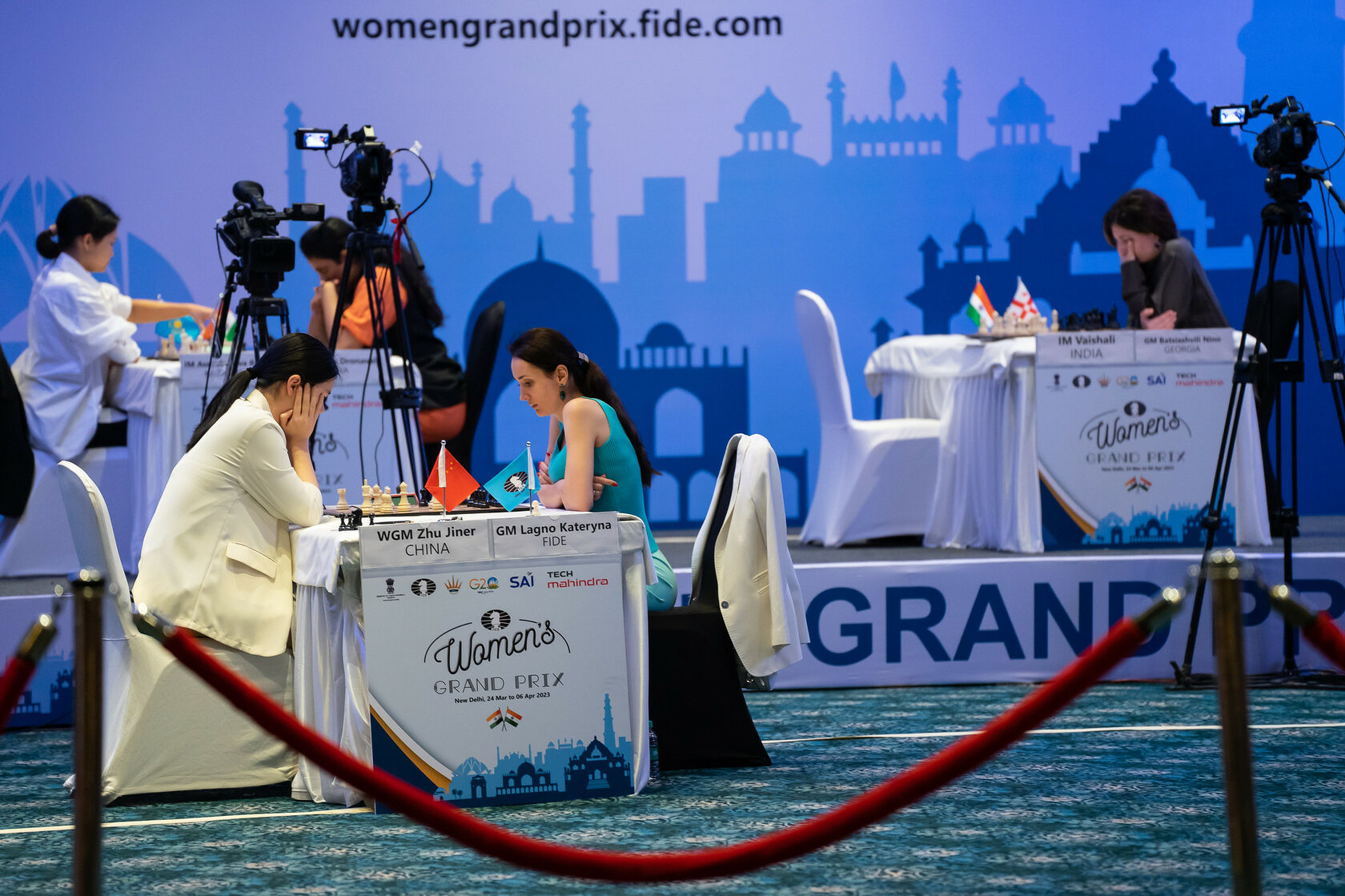
In a tense battle in the Sicilian, in what was only their second encounter so far, Zhu came out victorious against Kateryna Lagno. Zhu is now the leader with 3,5 points. Lagno is on two points.
Nana Dzagnidze was surprised by Humpy Koneru who grabbed the initiative early on in the Queen’s gambit declined. Despite efforts to hold back Black’s advances, Dzagnidze was powerless and lost. She now has 1,5 points while Koneru has 2,5.
Harika Dronavalli had a similar experience as Dzagnidze. Playing as Black against Bibisara Assaubayeva, in the Reverse Benoni, Dronavalli got into a passive position in the middlegame and couldn’t find a way out. After nearly five hours of play, spent mostly in defence, Dronavalli had to put up the white flag. A great comeback for Bibisara following a defeat in the fourth round. She is now on three points out of four games played, while Dronavalli has 2,5 (but with one bye).
In a game full of twists and turns, the youngest player in the tournament Vaishali Rameshbabu drew with Nino Batsiashvili of Georgia. The two played the Italian game, and the position was mostly even, but, towards the end, Viashali blundered and lost an exchange. Luckily for her, Batsiashvili blundered in return and, in the end, the two agreed to a draw.
Both have played only three games so far. Batsiashvili has two points while Vaishali Rameshbabu is on 1,5.
Let’s take a look at today’s games in more detail.
Nana Dzagnidze was surprised by Humpy Koneru who grabbed the initiative early on in the Queen’s gambit declined. Despite efforts to hold back Black’s advances, Dzagnidze was powerless and lost. She now has 1,5 points while Koneru has 2,5.
Harika Dronavalli had a similar experience as Dzagnidze. Playing as Black against Bibisara Assaubayeva, in the Reverse Benoni, Dronavalli got into a passive position in the middlegame and couldn’t find a way out. After nearly five hours of play, spent mostly in defence, Dronavalli had to put up the white flag. A great comeback for Bibisara following a defeat in the fourth round. She is now on three points out of four games played, while Dronavalli has 2,5 (but with one bye).
In a game full of twists and turns, the youngest player in the tournament Vaishali Rameshbabu drew with Nino Batsiashvili of Georgia. The two played the Italian game, and the position was mostly even, but, towards the end, Viashali blundered and lost an exchange. Luckily for her, Batsiashvili blundered in return and, in the end, the two agreed to a draw.
Both have played only three games so far. Batsiashvili has two points while Vaishali Rameshbabu is on 1,5.
Let’s take a look at today’s games in more detail.
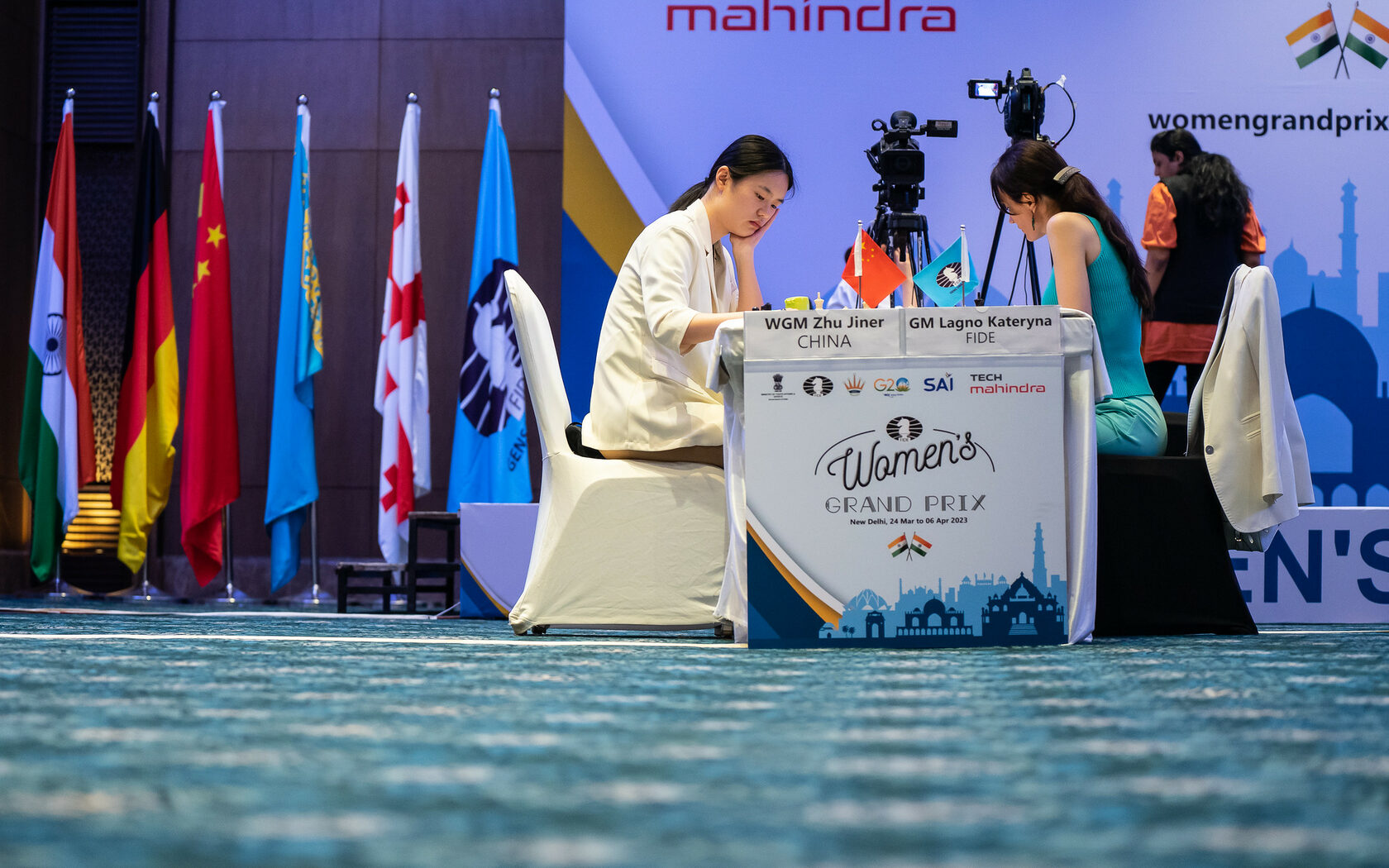
Zhu Jiner – Katerina Lagno
The two have met only once so far and Lagno came out victorious in the Four knights variation of the Sicilian Defence.
Now, in their second duel, the Sicilian Defence was played once again, but Lagno went for the Taimanov which quickly transposed into a topical line of Scheveningen which was very popular about 30 years ago.
Zhu implemented a standard plan for organising an attack on the black king’s fortress, while Lagno countered by aligning her queen and bishop on the a8-h1 diagonal, aiming at White’s monarch.
The two have met only once so far and Lagno came out victorious in the Four knights variation of the Sicilian Defence.
Now, in their second duel, the Sicilian Defence was played once again, but Lagno went for the Taimanov which quickly transposed into a topical line of Scheveningen which was very popular about 30 years ago.
Zhu implemented a standard plan for organising an attack on the black king’s fortress, while Lagno countered by aligning her queen and bishop on the a8-h1 diagonal, aiming at White’s monarch.
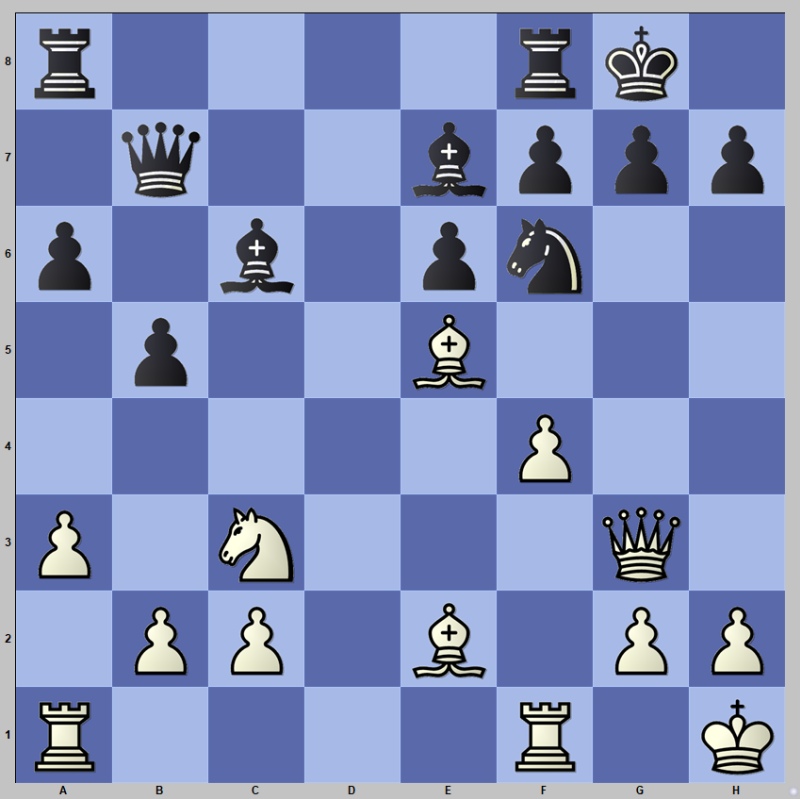
Zhu proceeded with her kingside push with 17.f5. However, Black had enough pieces, space and time to coordinate a response.
After 17…exf5 18.Rxf5 Kateryna found precise 18…Ne8! 19.Bd3 g6 20.Rf1 Rd8. Black maintained equality and the position was even.
Following the exchange of several other pieces, the two reached the following position.
After 17…exf5 18.Rxf5 Kateryna found precise 18…Ne8! 19.Bd3 g6 20.Rf1 Rd8. Black maintained equality and the position was even.
Following the exchange of several other pieces, the two reached the following position.

White is pressuring on f7 but Black can hold if playing precisely. For example after 27…Qd7 or 27…f6 Black is fine.
However, with about 10 minutes left on the clock, Lagno blundered 27…Nd6??, allowing White to execute some tactics for a winning position.
28.Nxh7! Kxh7 29.Rh3 Rh5 30.Rxh5 gxh5 31.Re5 Ne8
However, with about 10 minutes left on the clock, Lagno blundered 27…Nd6??, allowing White to execute some tactics for a winning position.
28.Nxh7! Kxh7 29.Rh3 Rh5 30.Rxh5 gxh5 31.Re5 Ne8
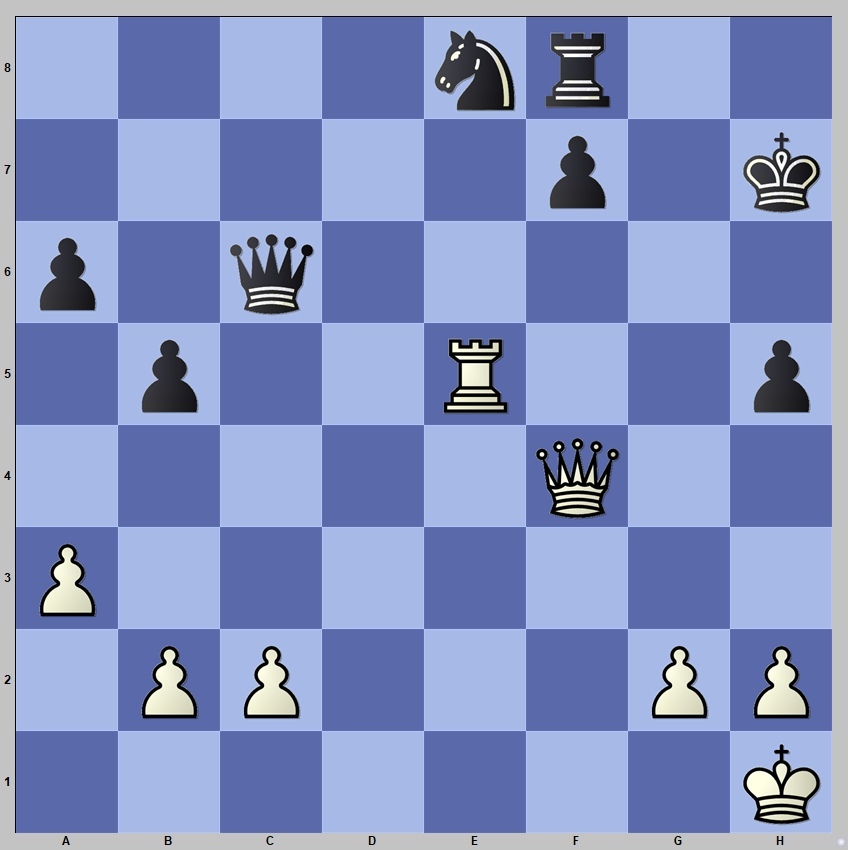
Now Black has to give up her queen. 32.Rxh5 Kg8 33.Qf5 Qg6 34.Rg5 Ng7 35.Rxg6 fxe6 36.Qd5+ Kh7 37.h3 White is winning. Her queen is dominating, her king is secure and White’s queenside passer will cost black a piece.
Zhu scored yet another victory in the Grand Prix in New Delhi and now has 3,5 points, while Lagno remains on two points.
Zhu scored yet another victory in the Grand Prix in New Delhi and now has 3,5 points, while Lagno remains on two points.
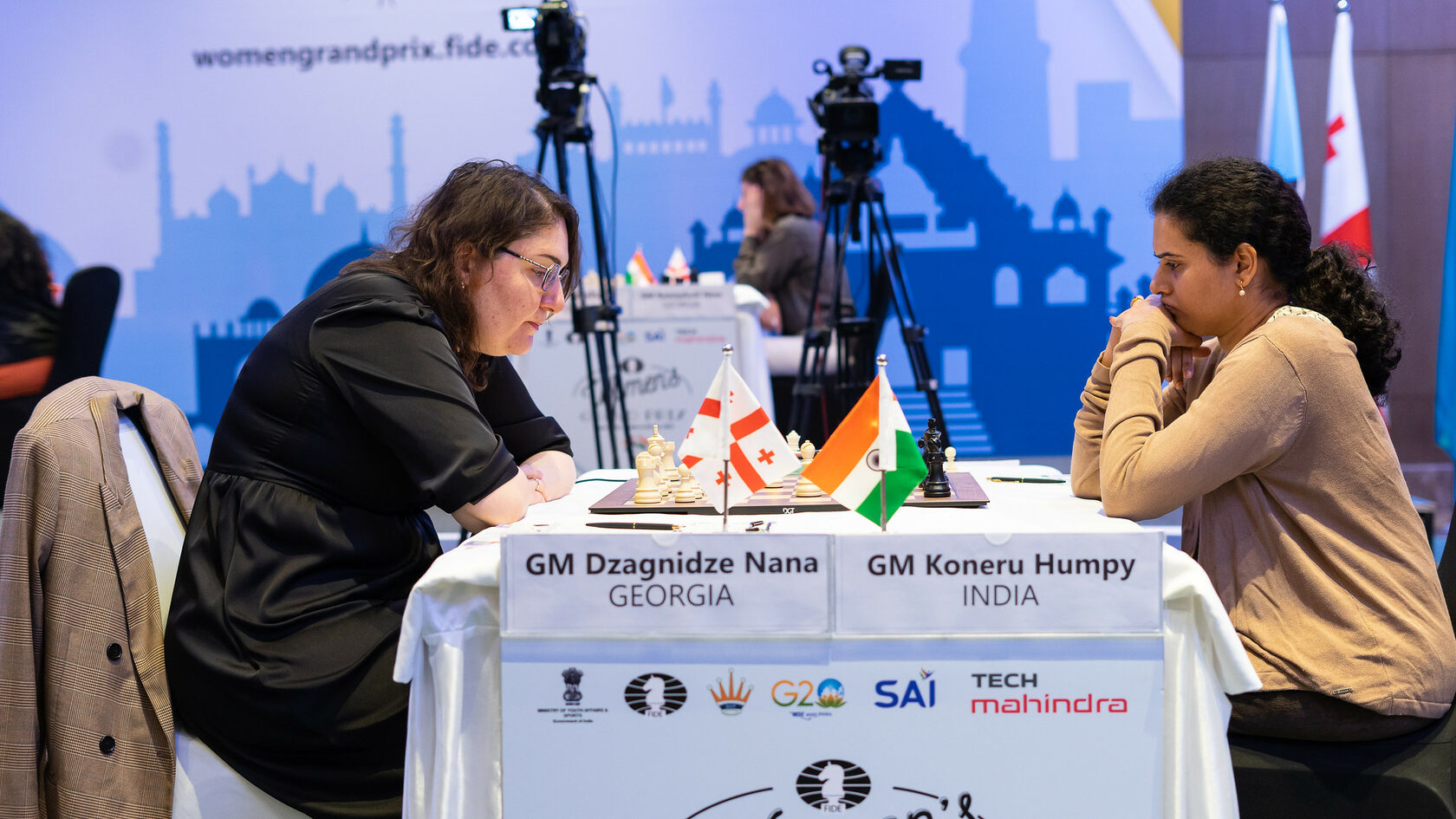
Nana Dzagnidze – Humpy Koneru
The two have played 29 games so far and each has nine victories, with 11 draws. After the fifth round in New Delhi, Humpy is in the lead.
Koneru opted to play the Queen’s Gambit declined, going for a sharp line with 5…Bb4. Nana seemed surprised and started spending much more time thinking. A sharp position emerged on the board soon after the first opening moves.
The two have played 29 games so far and each has nine victories, with 11 draws. After the fifth round in New Delhi, Humpy is in the lead.
Koneru opted to play the Queen’s Gambit declined, going for a sharp line with 5…Bb4. Nana seemed surprised and started spending much more time thinking. A sharp position emerged on the board soon after the first opening moves.
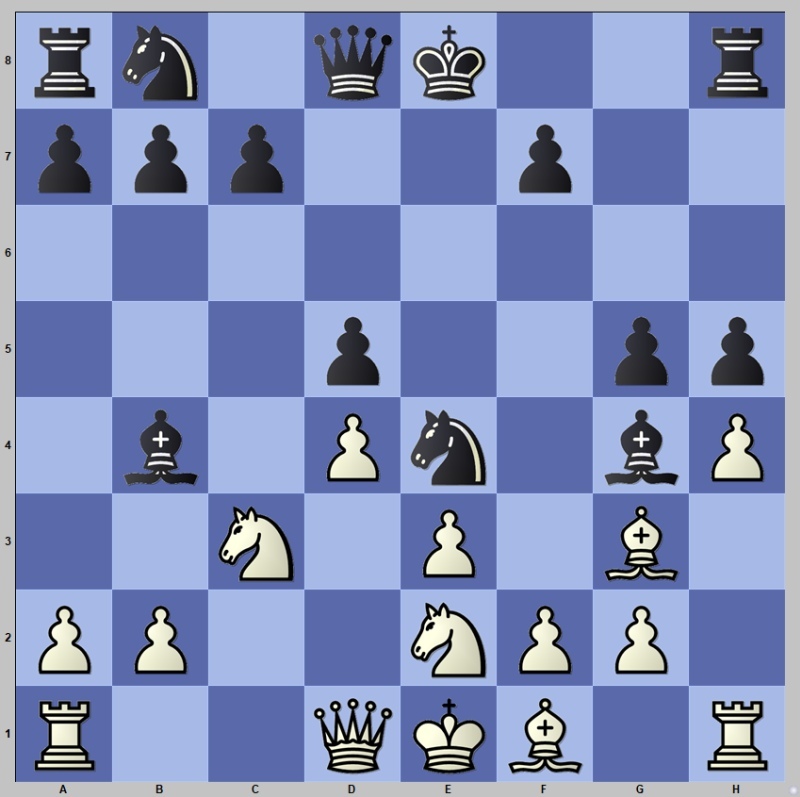
Here Dzagnidze played a dubious move (as it turned out later) 13.f3. After 11…Nxg3 12.Nxg3 Humpy introduced a novelty 12…Be6!
After this move (the first line of chess engines) Black is already slightly better. The opponents proceeded with 13.Qa4 Nc6 14.Bb5 and here Koneru opted to exchange her bishop on b4 for a knight on c3, after which the position became equal. A better choice was 15…Bd7.
However, just a couple of moves down the road Nana made a serious inaccuracy and Humpy got the upper hand.
After this move (the first line of chess engines) Black is already slightly better. The opponents proceeded with 13.Qa4 Nc6 14.Bb5 and here Koneru opted to exchange her bishop on b4 for a knight on c3, after which the position became equal. A better choice was 15…Bd7.
However, just a couple of moves down the road Nana made a serious inaccuracy and Humpy got the upper hand.

Nana just played 16.Qc2? but after 16…gxh4 17.Bxc6 Bxc6 Black emerged clearly better: she has a secure king, unexposed weaknesses and more active pieces and open lines on the kingside. On top of this, Nana was also short on time. Still, White had defensive resources, but Nana’s 24th move was a costly mistake.
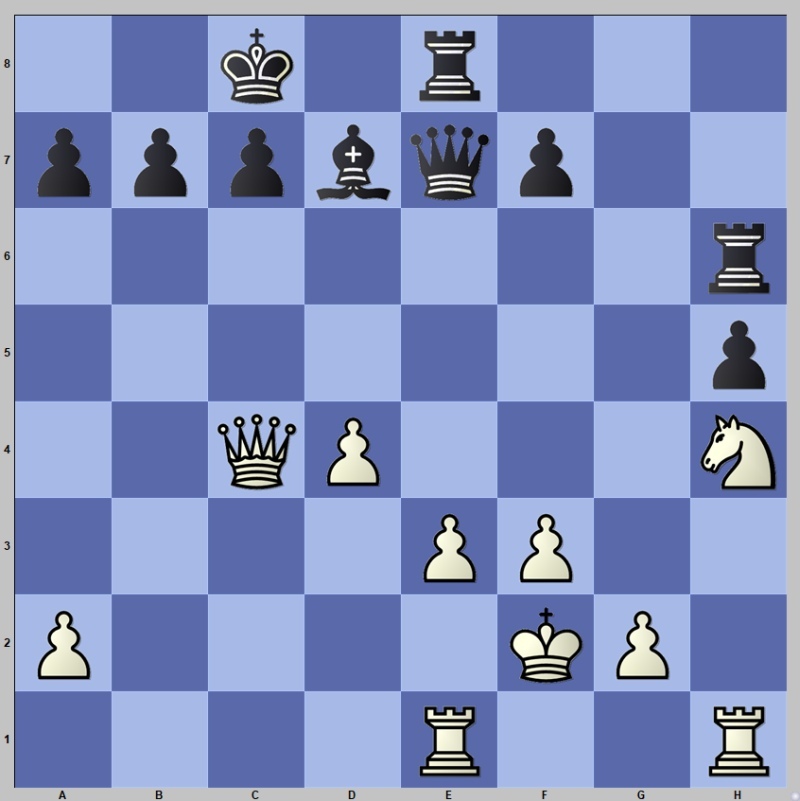
After 24.e4 (consolidating 24.Re2 was much better) Black managed to transfer her rook from h6 to the a-file, threatening White all along the width of the board. Ultimately, Dzagnidze lost the central pawn on d4.
But Nana was still fighting on. She picked up White’s h4-pawn and had three against one on the kingside, but it was not enough as Black’s heavy pieces were positioned well to penetrate White’s camp. Humpy first picked up the a2 pawn and then proceeded to pillage white pieces on the kingside.
Nana had no chances but still played on, in the spirit of the saying that “a game is never lost until you resign”. In the end, however, she had to accept the inevitable and capitulate.
Dzagnidze is now on 1,5 out of five games, while Humpy is on 2,5 points.
But Nana was still fighting on. She picked up White’s h4-pawn and had three against one on the kingside, but it was not enough as Black’s heavy pieces were positioned well to penetrate White’s camp. Humpy first picked up the a2 pawn and then proceeded to pillage white pieces on the kingside.
Nana had no chances but still played on, in the spirit of the saying that “a game is never lost until you resign”. In the end, however, she had to accept the inevitable and capitulate.
Dzagnidze is now on 1,5 out of five games, while Humpy is on 2,5 points.
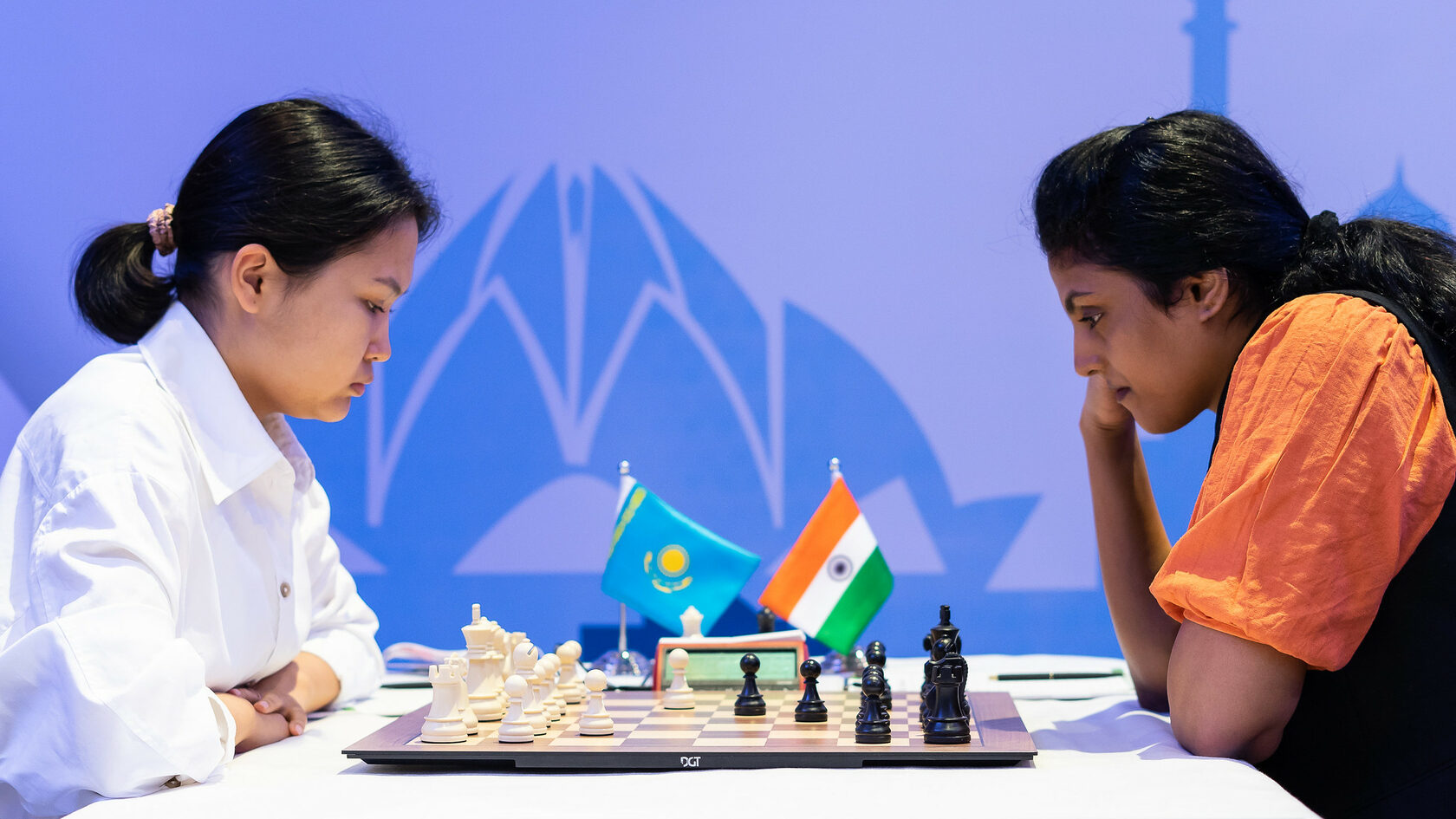
Bibisara Assaubayeva – Harika Dronavalli
The duel between Bibisara and Harika turned into a very original game. The two had an even score against one another until now – two victories each.
Following 1.c4 e6 Bibisara entered the so-called Reversed Benoni. After 2.g3 d5 3.Bg2 Nf6 4.Nf3 d4 White opted for a less common line – with 5.d3. After 5…Bb4+ 6.Nbd2, Black played a questionable novelty with 6…Be7 instead of the known move 6….a5. Bibisara had an interesting option 7.b4, but for some reason, she preferred not-so-strong 7.Ne5.
The game progressed to a dynamic position where White lost her castle and Black created a pawn wedge on e3.
The duel between Bibisara and Harika turned into a very original game. The two had an even score against one another until now – two victories each.
Following 1.c4 e6 Bibisara entered the so-called Reversed Benoni. After 2.g3 d5 3.Bg2 Nf6 4.Nf3 d4 White opted for a less common line – with 5.d3. After 5…Bb4+ 6.Nbd2, Black played a questionable novelty with 6…Be7 instead of the known move 6….a5. Bibisara had an interesting option 7.b4, but for some reason, she preferred not-so-strong 7.Ne5.
The game progressed to a dynamic position where White lost her castle and Black created a pawn wedge on e3.
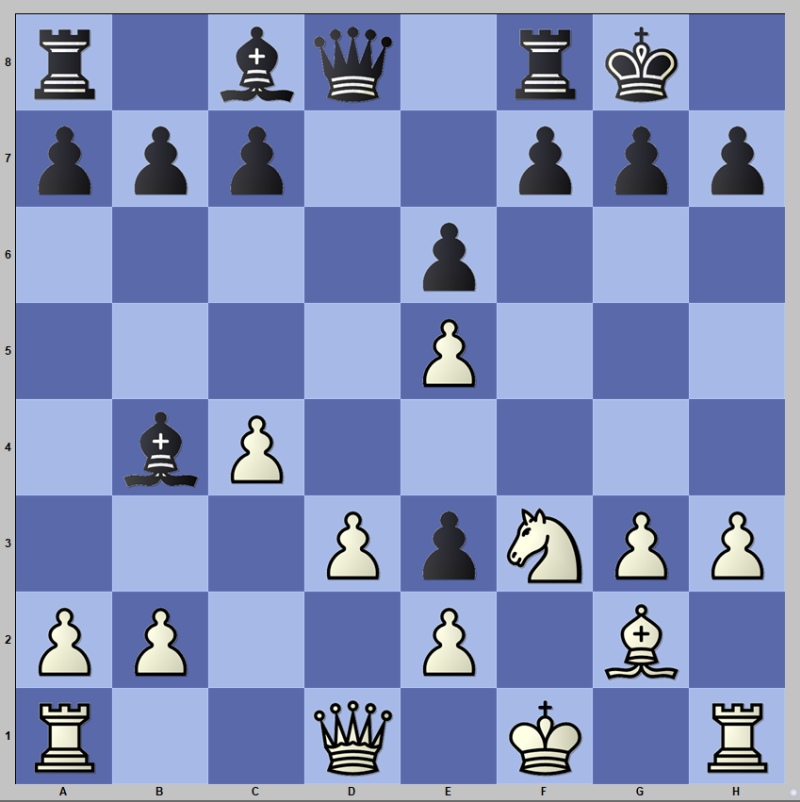
White plans to try and capture the advanced pawn on e3, while Black is trying to support it or sacrifice at the right moment. Bibisara played actively, simultaneously threatening the pawn, advancing her pawns, repositioning the heavy pieces and playing on both flanks, although Harika did not use all her chances (15…f6!). Gradually, Assaubayeva got a real edge and initiated her king transfer to the queenside, all the way to a2.
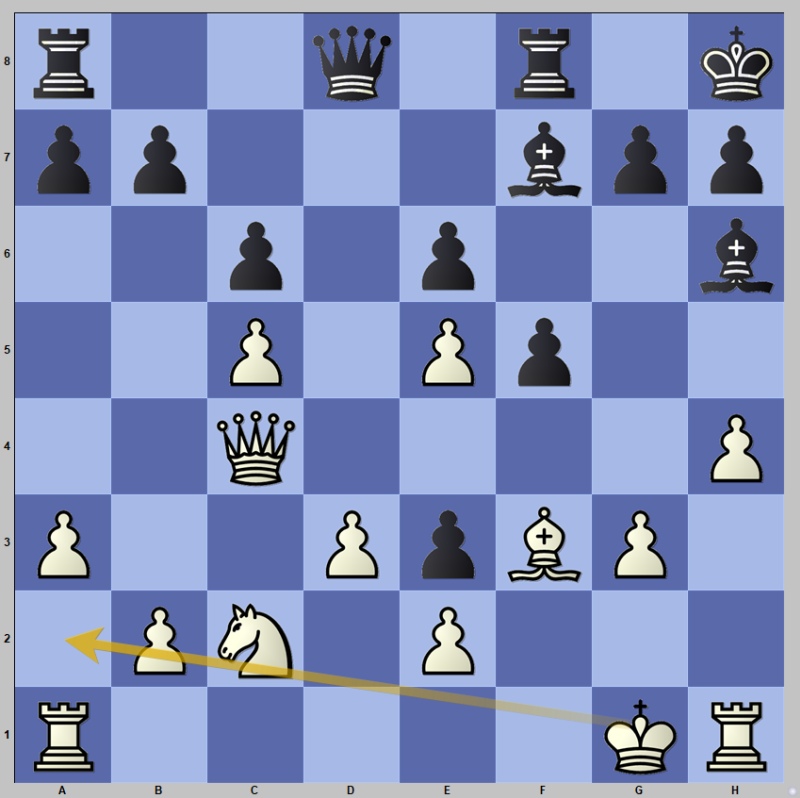
White has a clear plan: secure her king, activate her pieces and strike Black’s weak spots in the centre and on the queenside. Dronavalli started struggling here. She couldn’t find the right coordination of her pieces and went for an exchange on the queenside, which left her with a weak pawn structure and bishops blocked by her pawns.
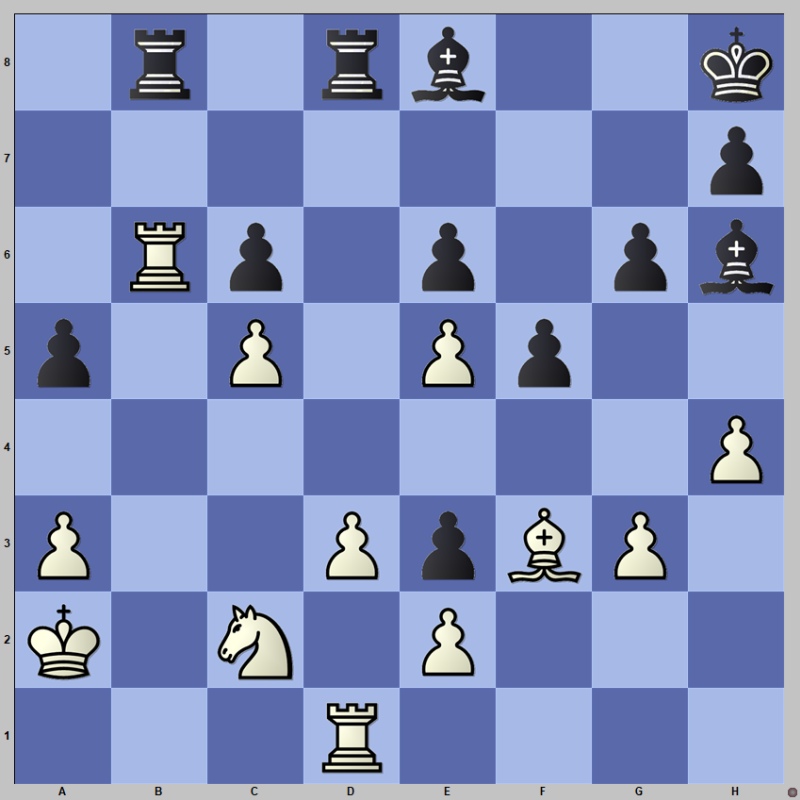
It is a triumph of White’s strategy. The best chance for Black was 36…f4, hoping to open the position and activate her black-squared bishop, although after 37.gxf4 Bxf4 38.d4 White’s is in full control.
After 37…Bg7 White’s task became even simpler. Bibisara created a stable pawn chain in the centre and plucked up Black’s weak pawns. The game lasted for another 24 moves, but there was no hope for Harika.
Bibisara has three out of four, while Harika is on 2,5 with one bye.
After 37…Bg7 White’s task became even simpler. Bibisara created a stable pawn chain in the centre and plucked up Black’s weak pawns. The game lasted for another 24 moves, but there was no hope for Harika.
Bibisara has three out of four, while Harika is on 2,5 with one bye.
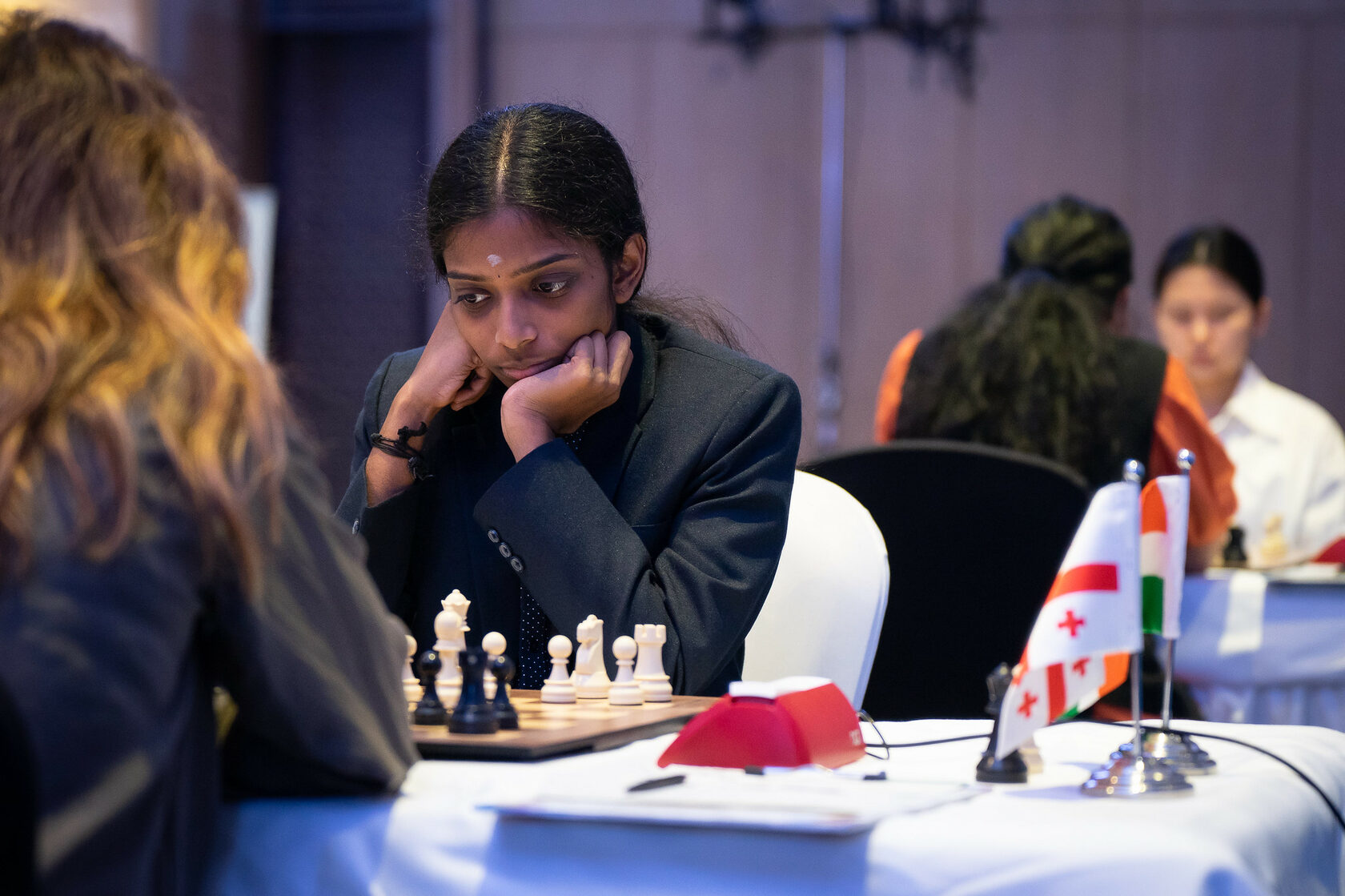
Vaishali Rameshbabu – Nino Batsiashvili
Out of their 11 games, Vaishali has claimed victory in five while Nino has only managed two. In their 12th duel, the Italian Game was played.
Nino employed a rare idea 9…Nh7 and solved all the opening problems.
Out of their 11 games, Vaishali has claimed victory in five while Nino has only managed two. In their 12th duel, the Italian Game was played.
Nino employed a rare idea 9…Nh7 and solved all the opening problems.

Vaishali couldn’t find the right way to escape Black’s pin on f3. She opted to open the centre with 15.d4 sacrificing a pawn for a pair of bishops and space advantage. White got sufficient compensation, but just a few moves down the road, the Indian IM made a real error.
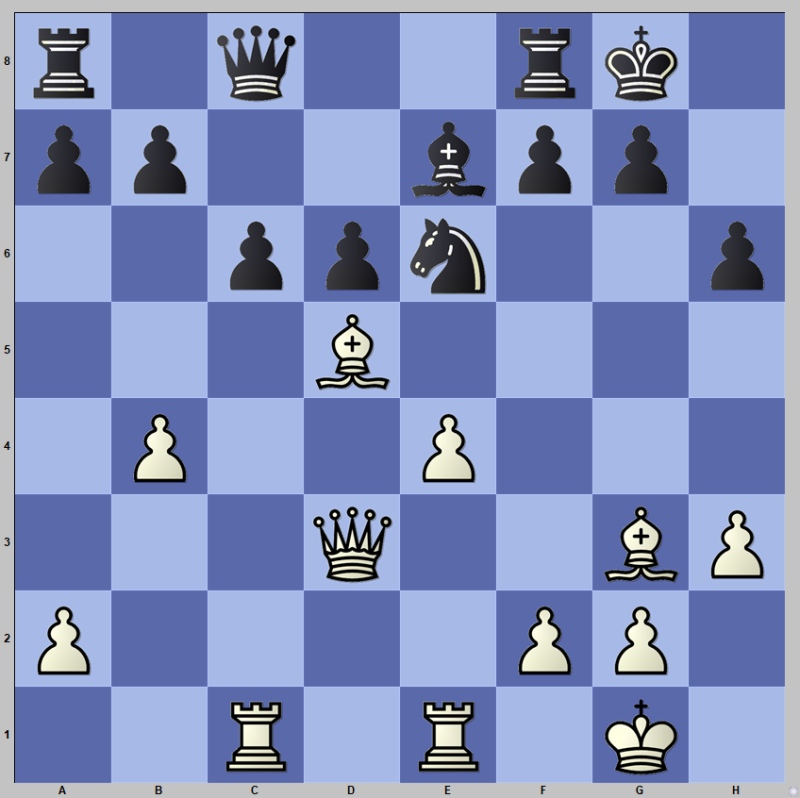
Vaishali needed to put her bishop on c4 or b3 and play for an even position. Instead, she blundered with 22.b5? In the post-game interview, Vaishali said she thought that was an interesting idea, giving her enough compensation.
After 22…Nc5, Black is much better – the knight is attacking the queen, covering the c-file and threatening to take the d5-bishop. White is forced to sacrifice an exchange on c5. After 23.Rxc5 dxc5 24.bxc6 bxc6 25.Bc4 Qd8, Batsiashvili offered an exchange of queens which White had to refuse and play 26.Qe2.
After 22…Nc5, Black is much better – the knight is attacking the queen, covering the c-file and threatening to take the d5-bishop. White is forced to sacrifice an exchange on c5. After 23.Rxc5 dxc5 24.bxc6 bxc6 25.Bc4 Qd8, Batsiashvili offered an exchange of queens which White had to refuse and play 26.Qe2.
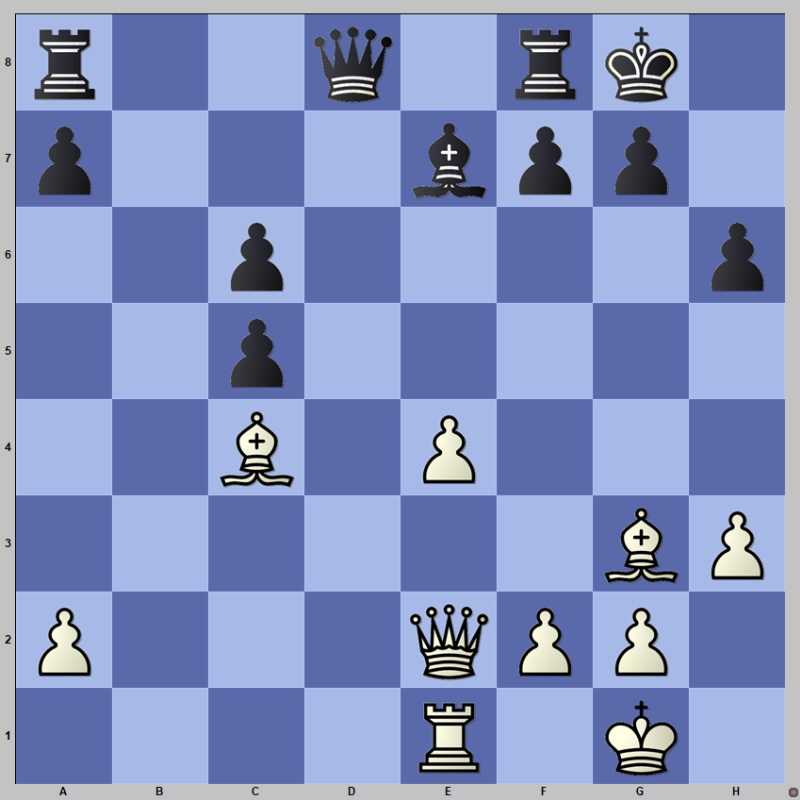
Here, however, Batisiashvili didn’t demonstrate the necessary accuracy. Instead of 22…Kh8! securing her king from the c4 bishop’s pin and then realigning her pieces for an attack, she played 26…Bh4? The evaluation changed immediately, as White jumped on the opportunity to reactivate her pieces - 27.Rd1 Qg4 28.Bd6 Rfe8 29.f4 Qg6 30.f5 Qf6 31.e5 Qf5 - which led to a roughly equal position.
Eventually, White regained an exchange, and the opponents headed into a dead-even rook and queen endgame where the two split a point. In the post-game interview, both players
judged the position after 26.Qe2 was mostly even and were surprised to hear the opposite.
Batsiashvili has two points, while Vaishali Rameshbabu is on 1,5. Both have played three games so far.
Standings after the fifth round:
Eventually, White regained an exchange, and the opponents headed into a dead-even rook and queen endgame where the two split a point. In the post-game interview, both players
judged the position after 26.Qe2 was mostly even and were surprised to hear the opposite.
Batsiashvili has two points, while Vaishali Rameshbabu is on 1,5. Both have played three games so far.
Standings after the fifth round:
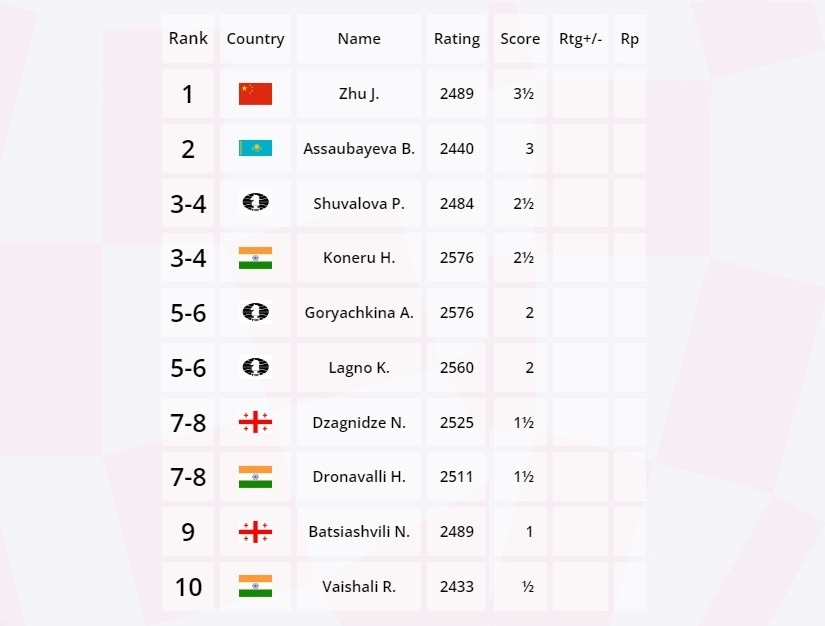
The sixth round of the third leg of the Women’s Grand Prix will take place on Friday, 31st March, at 3 PM local time.
The pairings of Round Six are:
Kateryna Lagno – Nino Bastiashvili
Aleksandra Goryachkina – Vaishali Rameshbabu
Polina Shuvalova – Bibisara Assaubayeva
Zhu Jiner – Nana Dzagnidze
Indian heavyweights Harika Dronavalli and Humpy Koneru have a rest day.
About the Women’s Grand Prix
The FIDE Women’s Grand Prix consists of four tournaments played between September 2022 and May 2023 and includes 16 women players who take part in three of the four tournaments. The two players who score the greatest number of cumulative points in the series shall qualify for the FIDE Women Candidates Tournament 2023-24.
The players participating in the Women’s Grand Prix have been selected based on their performance in key FIDE events and their ELO. Also, each of the four local tournament organisers has a right to nominate a player of their choice.
The time control for the tournament is 90 minutes for the first 40 moves, followed by 30 minutes for the rest of the game with an increment of 30 seconds per move starting from move one.
The total prize fund for each one of the four events is €80,000, with another €80,000 being distributed among the top eight players in the overall standings for the Grand Prix series.
General information about the venue and the dates
The third leg of the Women’s Grand Prix will take place in New Delhi’s Leela Ambience Convention Hotel. The five-star hotel is designed to cater to business events and large meetings and should make an ideal place for a tournament of this level.
The rounds will be played each day from 3 PM local time (9.30 GMT).
Press-officer: Milan Dinic
Photographer: Ismael Nieto
The pairings of Round Six are:
Kateryna Lagno – Nino Bastiashvili
Aleksandra Goryachkina – Vaishali Rameshbabu
Polina Shuvalova – Bibisara Assaubayeva
Zhu Jiner – Nana Dzagnidze
Indian heavyweights Harika Dronavalli and Humpy Koneru have a rest day.
About the Women’s Grand Prix
The FIDE Women’s Grand Prix consists of four tournaments played between September 2022 and May 2023 and includes 16 women players who take part in three of the four tournaments. The two players who score the greatest number of cumulative points in the series shall qualify for the FIDE Women Candidates Tournament 2023-24.
The players participating in the Women’s Grand Prix have been selected based on their performance in key FIDE events and their ELO. Also, each of the four local tournament organisers has a right to nominate a player of their choice.
The time control for the tournament is 90 minutes for the first 40 moves, followed by 30 minutes for the rest of the game with an increment of 30 seconds per move starting from move one.
The total prize fund for each one of the four events is €80,000, with another €80,000 being distributed among the top eight players in the overall standings for the Grand Prix series.
General information about the venue and the dates
The third leg of the Women’s Grand Prix will take place in New Delhi’s Leela Ambience Convention Hotel. The five-star hotel is designed to cater to business events and large meetings and should make an ideal place for a tournament of this level.
The rounds will be played each day from 3 PM local time (9.30 GMT).
Press-officer: Milan Dinic
Photographer: Ismael Nieto
